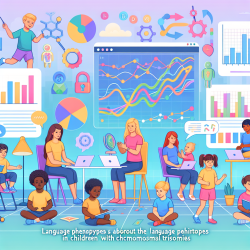The research article titled Language phenotypes in children with sex chromosome trisomies offers critical insights for practitioners working with children who have 47,XXX, 47,XXY, and 47,XYY karyotypes. This study, led by Dorothy V. M. Bishop and her colleagues, reveals substantial variability in language outcomes within these groups. Here, we explore how practitioners can leverage these findings to enhance therapeutic interventions and encourage further research.
Understanding the Research
The study recruited children aged 5-16 years and divided them into High Bias and Low Bias groups based on how they were identified. High Bias children were identified through neurodevelopmental investigations, while Low Bias children were identified through prenatal screening or other medical investigations. Key findings include:
- Significant variability within each trisomy group.
- No effect of trisomy type on language outcomes.
- High Bias children showed more severe language problems.
Implications for Practitioners
Practitioners can apply these findings in several ways:
- Individualized Assessment: Given the variability in language outcomes, it is crucial to conduct thorough, individualized assessments. Standardized tests and parent checklists can help identify specific areas of need.
- Early Intervention: Early identification and intervention can mitigate the impact of language disorders. Practitioners should work closely with parents and educators to monitor and support children from an early age.
- Tailored Interventions: The study suggests that interventions effective for children with developmental language disorder (DLD) may also benefit children with sex chromosome trisomies. Practitioners should consider evidence-based strategies tailored to each child's unique profile.
- Parental Guidance: When advising parents, emphasize the wide range of potential outcomes. While there is an increased risk of language problems, many children with trisomies develop within the normal range.
Encouraging Further Research
The study underscores the need for more extensive research to understand the language phenotypes associated with sex chromosome trisomies. Practitioners are encouraged to participate in or initiate studies that can contribute to this growing body of knowledge. Collaborative efforts can help identify genetic and environmental factors influencing language outcomes, ultimately improving therapeutic approaches.
To read the original research paper, please follow this link: Language phenotypes in children with sex chromosome trisomies.










